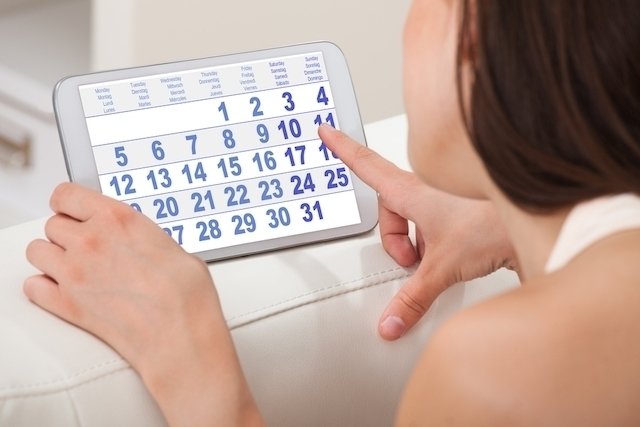The fertile period is the time in a woman’s cycle when ovulation occurs and there is a greater chance of pregnancy. It lasts about 6 days and happens about 10 to 14 days after the first day of your period.
The fertile period can be identified through some signs and symptoms, such as clear vaginal secretion, the appearance of pimples, increased body temperature, pain in the lower abdomen, emotional changes and increased appetite, for example.
Knowing exactly when the fertile period is is important for anyone trying to get pregnant, as it helps to identify a woman’s most fertile days. However, it should not be used as a natural contraceptive method. See which contraceptive method is best for you.

6 symptoms of a fertile period
The main symptoms that a woman is in her fertile period are:
1. Clear vaginal secretion
Transparent vaginal secretion, similar to raw egg white, is the first sign that the fertile period is approaching and, in this phase, a hormone called estradiol is released, which produces more liquid than usual, as if it were a mechanism of lubrication that helps sperm enter the vaginal canal.
In addition to being a sign of a fertile period, when the vaginal mucus becomes more fluid and transparent, sperm find it easier to reach the egg, facilitating fertilization.
2. Appearance of pimples
The appearance of pimples is common when the fertile period is close, as during this period a woman’s skin tends to become more oily, favoring the appearance of small blackheads and pimples, even after adolescence.
3. Slight increase in temperature
The increase in body temperature occurs due to the efforts made by the body to prepare for fertilization. During this period, the follicles release eggs, which increase the amount of a hormone called progesterone, which is responsible for increasing the temperature by 0.3 to 0.8ºC, which can be measured with a thermometer as soon as you wake up.
4. Increased libido and appetite
This symptom also occurs due to an increase in hormonal levels, making the woman feel more attractive and have more sexual desire.
5. Pain in the lower abdomen
Lower abdominal pain, which is pain in the lower part of the belly, more or less at the level of the ovaries, is one of the most common symptoms. Some women may experience cramping pains that appear and disappear, which is a concrete indication that they are ovulating.
6. Irritation and emotional instability
Mood variation is also common during the fertile period, occurring mainly due to common hormonal changes during the period.
Women who are trying to get pregnant but have difficulty calculating their fertile period or cannot identify their symptoms can choose to take an ovulation test that can be purchased at the pharmacy. See how it works and how to take the ovulation test.
When is the fertile period
The fertile period is normally 10 to 14 days after the first day of menstruation and lasts about 6 days.
Consult your nearest gynecologist, using the following tool, to find out more about the fertile period:
Taking care of your health has never been easier!
How to calculate the fertile period
To find out when your fertile period is, enter the data into the calculator below:
To calculate the fertile period manually, you must add 14 days to the first day of the last menstruation and then add 3 days before and 3 days after, to identify the 6-day interval, which corresponds to the fertile period.
Understand better how the calculation is made to know when the fertile period is, including in cases of irregular cycle.
What is the most fertile day?
The most fertile day is the day of ovulation and the period 3 days before and 3 days after ovulation. At this stage, fertilization is more likely to occur if the woman has unprotected intimate contact, and favor pregnancy.
Furthermore, as the egg, once released from the ovaries, has a “life” of around 24 hours, the day after ovulation can also be one of the most fertile days.
Bibliography
- SIMMONS, R. G.; JENNINGS, V. Fertility awareness-based methods of family planning. Best Pract Res Clin Obstet Gynaecol. 66. 68-82, 2020
- BLAKE, K. R.; et al. Standardized protocols for characterizing women’s fertility: A data-driven approach. Hormones and Behavior. 81. 74-83, 2016
- WORLD HEALTH ORGANIZATION. Methods Based on Fertility Perception. 2007. Available at: <http://www.saudedireta.com.br/docsupload/1340374285Portuguese-Chapter17.pdf>. Accessed on 03 Dec 2019
- NATIONAL HEALTH SERVICE. How can I tell when I’m ovulating?. Disponível em: <https://www.nhs.uk/common-health-questions/womens-health/how-can-i-tell-when-i-am-ovulating/>. Acesso em 03 dez 2019
- STIRNEMANN, Julien J. et al. Day-specific probabilities of conception in fertile cycles resulting in spontaneous pregnancies . Human Reproduction. Vol.28, n.4. 1110-1116, 2013
- AMERICAN PREGNANCY ASSOCIATION. Understanding Ovulation. Disponível em: <https://americanpregnancy.org/getting-pregnant/understanding-ovulation/>. Acesso em 03 dez 2019

Sign up for our newsletter and stay up to date with exclusive news
that can transform your routine!
Warning: Undefined array key "title" in /home/storelat/public_html/wp-content/plugins/link-whisper-premium/templates/frontend/related-posts.php on line 12
Warning: Undefined array key "title_tag" in /home/storelat/public_html/wp-content/plugins/link-whisper-premium/templates/frontend/related-posts.php on line 13



